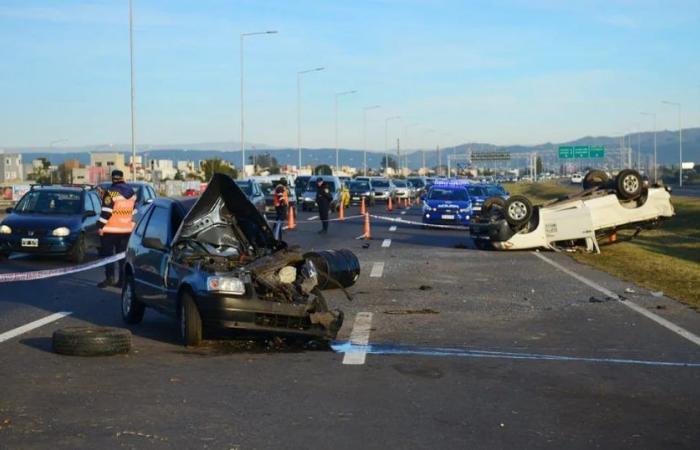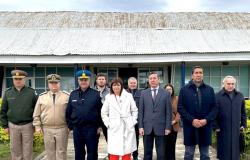Circunvalación Avenue is the fastest artery in the city of Córdoba, which allows connecting distant points without having to cross through the Center. It offers three traffic lanes, its pavement is in impeccable condition and it is fully illuminated. But it also has worrying data. According to the records of The voiceat least 18 people lost their lives in the last 18 months, while the Government of Córdoba reports 17 fatalities in 2023 and three so far in 2024.
It is the avenue with the most deaths in the entire city. According to the survey carried out by the Bloomberg Initiative for Global Road Safety (BIGRS) on deaths due to road accidents in the Capital between 2017 and 2022, Sabattini Avenue added 20 deaths in five years.
Arturo Illia, which is the continuation of Sabattini from Tránsito Cáceres de Allende to Independencia, with just seven blocks that accounted for 15 deaths between 2017 and 2022. Colón Avenue, which enters the Center from the west, was the scene of road accidents that left 14 dead. Armada Argentina Avenue, near Villa El Libertador – in the southwest of the capital – registers 13 fatalities. The fifth avenue with the most deaths in crashes is Leandro N. Alem, in the north, with 12.
The three lanes of the Ring Road were completed in August 2021. According to data from the provincial government, in 2022 there were nine deaths, while in 2023 the figure increased to 17, and so far in 2024 there have already been three deaths. There are 29 fatalities in two and a half years.
What influences that figure to be so high? The voice consulted road safety specialists. And they pointed out three factors: infrastructure, control and conduct.
Master civil engineer Paula Marchesini, specialist in Road Safety and coordinator of mobility and safe infrastructure at the Bloomberg Initiative for Global Road Safety (BIGRS) in Córdoba, emphasizes the need for a comprehensive and multifaceted approach to address this problem. “In general terms there is a problem of road insecurity. The number of deaths is high, and even more so taking into account the new paradigm of the safe approach, which proposes that there be no deaths or serious injuries on the roads,” explains Marchesini.
A multi-causal problem
Marchesini highlights that the only way to address these problems is from different angles. “On the one hand, we have the infrastructure. On the other hand, there is the issue of the vehicle, the vehicle fleet and the state of the cars,” he indicates. However, he emphasizes that raising awareness among all traffic participants cannot be left aside. “Ongoing training is essential. It cannot be that a person gets their license at 18 and does not need further training until they are 70,” he argues.
In this sense, Marchesini emphasizes the need for citizen awareness campaigns through the media and other platforms. “It’s one thing to know that I have to go 60 km/h and another thing to understand why exceeding the limits is dangerous, especially in adverse conditions like rain,” he adds. In addition, he mentions the importance of control and supervision, and rapid response to emergencies. “That’s something that’s not talked about much, but it’s also crucial. “The golden hour is vital for survival.”
Infrastructure and education
Regarding the infrastructure of the Beltway, Marchesini points out that the width of the lanes invites drivers to travel at high speeds, often without realizing the risk. “If there is no control and education, signage alone is not enough,” he says.
Miguel Ángel Rizzotti, director of Traffic Accident Prevention of the Government of Córdoba, agrees on the need to address the problem from different perspectives. “In the production of road accidents, three factors interact that make up the ‘road trilogy’: the human factor, the vehicular factor and the environmental factor,” explains Rizzotti.
According to their data, 90% of accidents are due to failure to comply with traffic regulations. “This leads us to conclude that many of these incidents could have been avoided,” he notes.
Rizzotti emphasizes the importance of education and awareness, as well as control and sanction, as fundamental pillars to change the behavioral habits of road users. “Road accidents are multi-causal: speed, improper overtaking, alcohol and other substances, fatigue, stress, taking drugs, seat belts, distractions such as cell phone use, etc. All this leads us to conclude that in 90% of cases these are incidents that could have been avoided,” he argues.
What the data says
The data on accident rates on the Beltway are alarming. In 2022 there were nine deaths, while in 2023 the number increased to 17, and so far in 2024 there have already been three deaths. “Since the creation of the General Directorate for the Prevention of Traffic Accidents (DGPAT) in 2008, we recorded 570 deaths, a figure that decreased until reaching 398 in 2023, when in the same period the vehicle fleet grew more than 130%,” explains Rizzotti.
The Highway Police play a crucial role in controlling and patrolling the routes, in addition to assisting drivers. “The Province of Córdoba is seen in the country as a model to follow in its public policies on road safety,” says Rizzotti.
The province develops a comprehensive driver education program, teaches courses and workshops, and grants license plates to traffic operators and evaluators who pass the exams. “The challenge is to win the cultural battle, to raise awareness among the population about respect for norms, which is nothing more than respect for others and love for one’s own life and that of others,” he concludes.
Horacio Botta Bernaus, a lawyer specializing in road safety, also emphasizes the importance of the human factor in the generation of accidents. “You have very violent events where no one dies and less violent events with tragic results. When we talk about a dangerous place, it does not necessarily have to do with the number of deaths, but with the number of risks that are generated,” explains Botta Bernaus.
Botta Bernaus criticizes the lack of comprehensive traffic management in Córdoba, pointing out that there is no adequate intervention in the preparation of drivers. “Road safety education is a professional activity that requires practical and continuous training,” he indicates. Additionally, he mentions that a wide road, like the Beltway, tends to encourage higher speeds, which increases risk.
Finally, Botta Bernaus highlights that the causes of accidents are diverse and are often related to human behavior. “A departure from the road, a rear-end collision, a rollover, all of these incidents have in common the lack of appropriate conduct on the part of the drivers,” she points out. “Neither speed alone is a problem, nor control alone is the solution, but both must be accompanied by continuous and effective education.”






